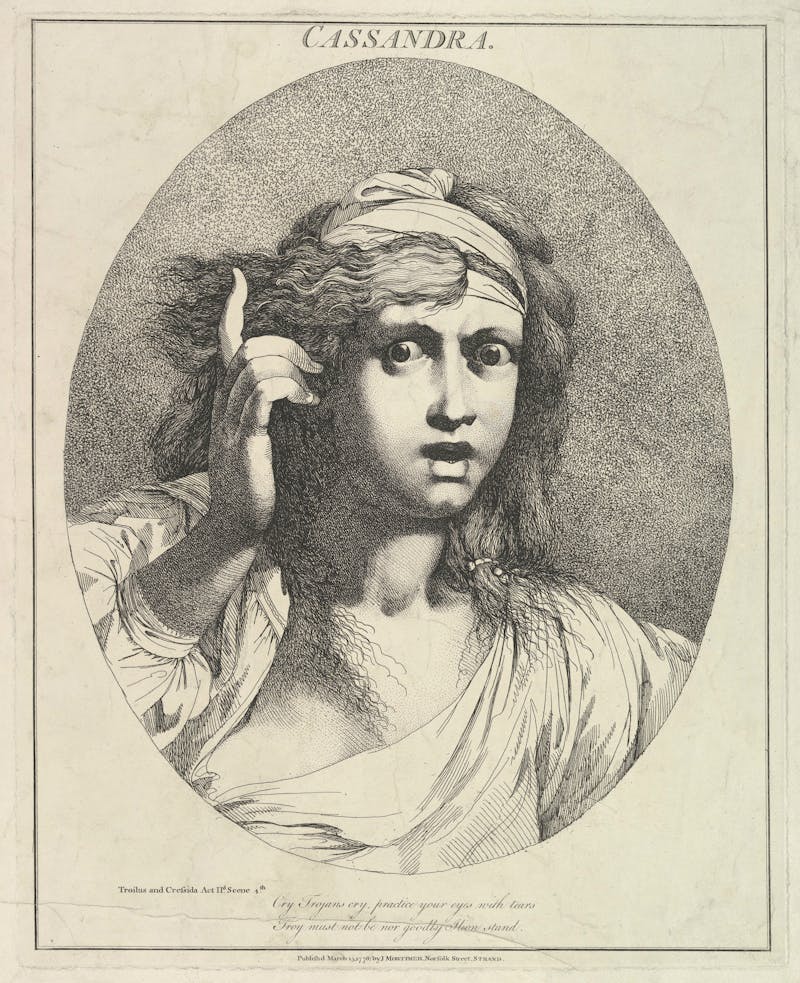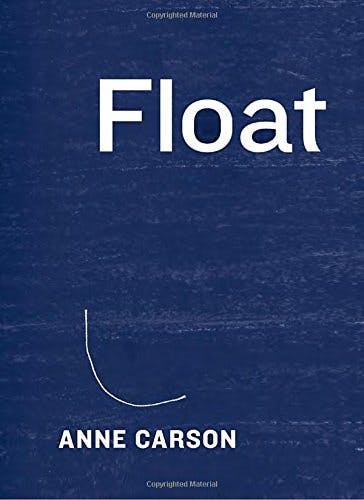
I love Anne Carson’s work dearly though I suspect I am too stupid for it. I don’t speak any language other than English and there’s much of the Western canon I haven’t studied, so when Carson invokes Hegel or any of the many less famous Greek tragedies, I feel the rumbling of low-grade panic. Carson herself has said of her writing, “i feel i am blundering in concepts too fine for me [sic].” In her latest book Float, an unbound collection of twenty-two separate booklets, she even proposes “an other competence” to combat or correct the notion of incompetence.
I suppose we all experience intellectual insufficiency from time to time. But poetry especially seems to inspire an unusual amount of insecurity in both its writers and readers, as Ben Lerner noted in this year’s The Hatred of Poetry. He even defines poetry, in part, as “an art hated from without and within.” Carson creates plenty of non-poems; Float includes lectures, plays, essays, and performance pieces. Yet the sensibility of (good) poetry permeates her texts—the language is eclectic, unexpected and exact; the voice singular, idiosyncratic—and she rejects any distinction between forms, explicitly and in practice. “Don’t like boundary” reads one line of “Maintenance,” a piece mainly comprised of instructions for setting up an art installation. Float, as the name suggests, resists calcification on both a micro and macro level. It wants to remain in flux, perhaps because its concepts are too fine to merit certainty’s stillness.
Here as in her previous works, Carson’s words further derive a poetry-like quality from their sensation of flighty nearness: Something profound is glimpsed, intuited in her lines...but what? Could it be named? (“Your sob has a name,” the Greek chorus of Float’s “Pinplay” tells a main character, without giving that name up.) I’ll give you an example of her own interest in this nearness. In “Cassandra Float Can,” Carson drifts between the voices of Cassandra (the figure from Greek mythology), the “anarchitect” artist Gordon Matta-Clark, and mathematician-philosopher Edmund Husserl. She is fascinated by moments in which “there is some action of cutting through surfaces” not because of a trite conviction that equates the superficial with the flimsy or false, but because underneath dwells something unexpected, potentially untranslatable. “The etymologist makes cuts that show Being as it floats inside things,” she writes. And this is what Float, too, works toward: a slice of revelation.
Here’s another example, a related one. In “Variations on the Right To Remain Silent,” Carson invokes Joan of Arc, painter Francis Bacon, and German writer Friedrich Holderlin to probe the idea of a cliché, the limits of language, and the limits of translation. “Languages are not algorithms of one another, you cannot match them item for item,” she says, adding “what if [there is] a word that does not intend to be translatable.” She calls this “a word that stops itself,” and writes: “in the presence of a word that stops itself, in that silence, one has the feeling that something has passed us and kept going, that some possibility has got free.” There it is again, that indescribable nearness, the sense of proximity to something words can’t identify.

The twenty-two selections of Float seem to be presented as a group because they were unpublished loose ends without any place else to go. There is no indication they were conceived as components of an overarching conversation and yet collectively, they gesture toward one. If we were together in person I could diagram it for you like we were in a TV crime drama: on a wall, with red thread taut between many tacks. Here is every instance in which she discusses madness, every time a piece plays with the notion of pronouns. Much of Float is divorced from the terms of its creation; the works’ founding contexts sometimes included music, dancing, and the accompaniment of other visual art but here there is only print. “Reading can be freefall,” the book’s packaging says. I’m not sure there’s another option.
That recycling of ideas, of themes (the operations of sound; the challenges of translation; the information inside silence) is a symptom of her desire for maximum variation, maximum flexibility. Carson will come at something—the unnamable thing—from one angle, and then another, and usually still others: an investigation by many cuts. It’s how, in “Uncle Falling,” she manages to unite helmets with the concept of hell, with scenes from Iliad, with the choreography of Elizabeth Streb, with sponges. And how, in “Contempts,” she goes from the notion of “selling out” to Greek aristocracy’s handling of wealth to a declaration of admiration for Brigitte Bardot with many other stops between. Throughout Float there are melodies and reprisals, ideas revised, revisited, and flipped. It’s a sophisticated piece of mental music, though that doesn’t mean every repetition and echo was forethought. Caron’s admitted to using a random integer generator in her work and embracing accidental formatting changes, explaining “it saves you a lot of worry.” She practices intentional unintentionality.
Poets, and maybe most writers, struggle to relay experiences or insights that may be fundamentally unspeakable, beyond the reach of language. Remember Carson’s sensation of blundering. It rings true, then, when Ben Lerner argues poems are “always a record of failure,” tangible proof of the great chasm between what the human spirit wants to convey and what it is able to. This is also a plausible explanation for the intense reward that comes with quoting poetry, snapping it off into its best bits for a unit that can stand alone or else be embedded like a strut inside one’s own writing.
To pull the most evocative phrases from a piece also creates the illusion that the whole is as seamlessly powerful as that isolated part, a hammer-strike of sustained perfection. As Lerner puts it, “lines of poetry quoted in prose preserve the glimmer of the unreal [...] the echo of poetic possibility,” but this phenomenon is not unique to poems. Something similar is at work when friends text each other pictures of paragraphs from a novel, or when a blogger quotes a passage of an essay on tumblr. I keep an ever-expanding document of the lines I’m most struck by in whatever I’m reading at the moment. This tendency of mine is probably the reason I’m still so annoyed with Richard Sikken’s complaint about readers who lift phrases: “I crafted poems — units made out of lines placed in a specific order — and the poems have disappeared. My loveseats have been broken into chairs, into matchsticks.”
Anne Carson lives for the breaking up, the separation. She’s trafficked in fragmentation for a long time: Her career as a scholar of ancient works, which are often fragmentary or have no definite author, required becoming intimate with the incomplete, the impossibility of completion. Likewise, Float revels in its splintered state more than any of her previous titles. The unordered booklets (or “chapbooks”) evince internal derangement, too. One poem, “By Chance the Cycladic People,” is apparently deconstructed and reassembled out of order—perhaps by the aforementioned randomizer—with numerical clues left that point to a more intellectually logical progression. “Candor” also plays with numbers, with sections titled “Could I” (or “Could 1,”) “Then 3,” and “Double 2.” Carson quotes liberally (Hobbes, Aristotle, Keats) and scatters her words around others.’ She rewrites her own translation of an ancient poem many times over while only using words taken from Bertolt Brecht’s FBI file, then words displayed in and around London’s Underground, then a single page of Samuel Beckett’s Endgame.
As a writer, Carson dwells in a space of disintegration because she doubts the existence of a cohesive whole. “Act so that there is no use in the center,” Maggie Nelson writes in The Argonauts, while quoting Carson, who was in turn quoting Gertrude Stein. She remembers an interview in which Carson responded to some questions with no answer other than brackets. If you’ve read If Not, Winter, Carson’s translations of Sappho’s fragments, you know she’s written a book composed largely of those same brackets. Emptiness is not quite nothingness, and even nothingness is its own something. In Carson’s short version of Euripides’ Bacchae, one of the characters enters the stage carrying a head “impaled on a lacuna.” There is no discomfort with cavities, with silence, with the spaces in between. Without space, there cannot be movement or suspension.
Calling one’s self “stupid” is akin to saying “my mind doesn’t work like that.” It’s a way of recognizing the distance between the functioning of your mind and the functioning of someone else’s. An experience of our own stupidity, then, is a privilege afforded to us by the best art and maybe especially by the best poetry: We are granted the opportunity to swim a lap in the pool of someone else’s brain, if we can.
“I like to write lectures,” says Lecturer II in “Uncle Falling,” one of the booklets in Float:
My favorite part is connecting the ideas. The best connections are the ones that draw attention to their own frailty so that at first you think: what a poor lecture this is—the ideas go all over the place and then later you think: but still, what a terrifically perilous activity it is . . . How light, how loose, how unprepared and unpreparable is the web of connections between any thought and any thought.”
The chorus asks, “How about getting from here to there” to which one chorus member answers, alone, “how about spending some time in mid-air.” In other words, how about floating?